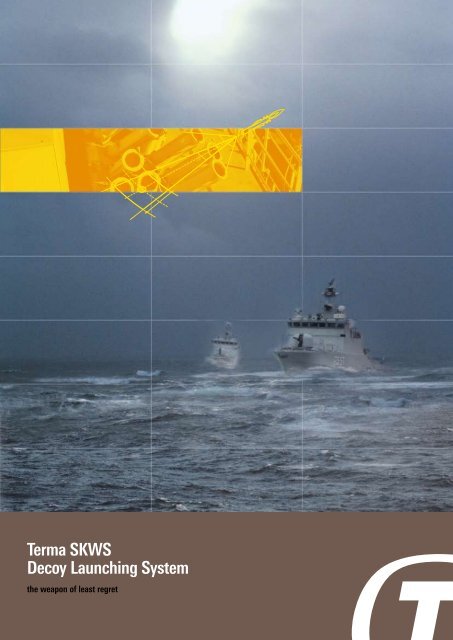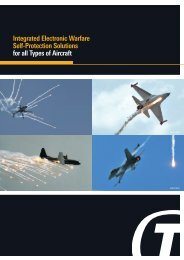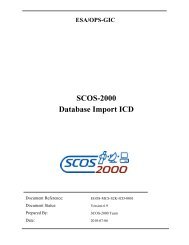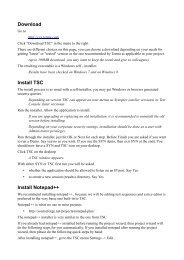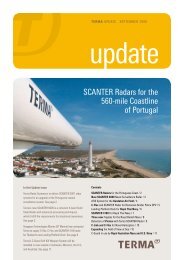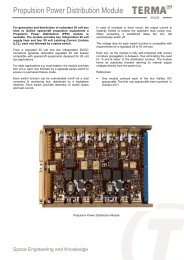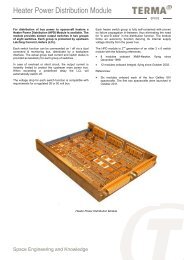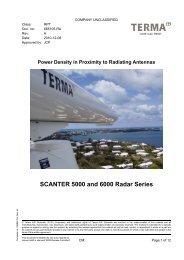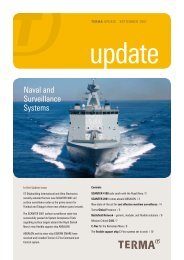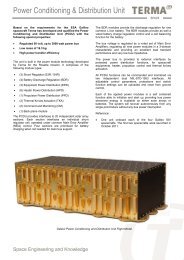Create successful ePaper yourself
Turn your PDF publications into a flip-book with our unique Google optimized e-Paper software.
<strong>Terma</strong> <strong>SKWS</strong><br />
<strong>Decoy</strong> <strong>Launching</strong> <strong>System</strong><br />
the weapon of least regret
<strong>Terma</strong> <strong>SKWS</strong> <strong>Decoy</strong> <strong>Launching</strong> <strong>System</strong><br />
The anti-ship missile threats continue to increase and evolve.<br />
New missiles are faster, stealthier, more manoeuvrable, and<br />
increasingly more intelligent with regard to target discrimination<br />
and electronic counter-countermeasure functionality, a<br />
development leaving recent generations of hard- and soft kill<br />
systems less effective.<br />
The use of hard-kill is further limited with the increasing<br />
peacekeeping and controlling activities in littoral waters where<br />
the release of weapons frequently is bound by strict engagement<br />
rules, but also requiring fast reaction time calling for a high<br />
degree of automation. In this situation, soft-kill i.e. decoy<br />
systems, have come to be seen as the non-aggressive selfdefence<br />
solution, a weapon of least regret.<br />
<strong>Decoy</strong> systems are today fitted to all naval war vessels ranging<br />
from fast attack crafts, mine warfare vessels, frigates to even<br />
bigger units as LPD’s as a key element in their electronic warfare<br />
suites. Integrated with the ship EW and Radar sensor assets the<br />
decoy system will provide fast and intelligent firing of all types<br />
of off-board decoys.<br />
For high value and larger units, the advent of Active Offboard<br />
decoys provides improved defence. A further extension of the<br />
decoy launching system is to fire acoustic decoys as part of the<br />
ship’s torpedo defence suite.<br />
The <strong>Terma</strong> Soft Kill Weapon <strong>System</strong>, <strong>SKWS</strong>, fulfils all these<br />
demands.<br />
<strong>Terma</strong> <strong>SKWS</strong> is a modern decoy launching system that can fire<br />
all existing 130 mm decoys – also known as SeaGnat decoys. The<br />
system is based on two <strong>Terma</strong> DL-6T launchers for small vessels<br />
or two <strong>Terma</strong> DL-12T launchers for larger vessels, one for port<br />
and one for starboard mounting. The system may be expanded<br />
to control up to 24 firing tubes on each side of the ship. The<br />
<strong>Terma</strong> launcher is designed to provide 360 degrees coverage<br />
against attacking anti ship missiles. This is obtained by carefully<br />
positioning a decoy from one of the multi-angular launchers.<br />
The key system features include:<br />
- Lightweight launchers with small footprint<br />
- Low pressure deck mounts<br />
- Effective 360° horizontal coverage<br />
- Advanced launch algorithms<br />
- Fully automated operation<br />
- Support of all SeaGnat type decoys<br />
- Support of SIREN Active Jammer <strong>Decoy</strong><br />
- High flexibility and easy integration of user defined algorithms<br />
and libraries<br />
The 130 mm decoy ammunition is supported throughout NATO<br />
and around the world with more than 500 systems in service.<br />
The high number of systems in service has promoted a continuous<br />
development of decoys from different and competing sources.<br />
Currently the following types of decoys are available and<br />
supported by <strong>Terma</strong> <strong>SKWS</strong>:<br />
- Seduction Chaff: SeaGnat 214<br />
- Distraction/Confusion Chaff: SeaGnat 216 / PW216<br />
- Infrared Rounds: PIRATE / GIANT (MK245 and DM19A1) / TALOS<br />
- Dual Mode (RF and IR) decoys: Chimera and Bullfighter<br />
- Torpedo <strong>Decoy</strong>s: LEAD MK12, MK13, MK14, MK15, and LESCUT<br />
An upgrade kit provides full support of:<br />
- SIREN Active Offboard <strong>Decoy</strong><br />
- PW 216 Distraction Chaff with automatic range programming.<br />
Chimera decoys loaded Chimera decoy Pirate IR decoy SIREN
The <strong>System</strong><br />
The Soft Kill Weapon <strong>System</strong> (<strong>SKWS</strong>) is divided into above deck<br />
and below deck equipment. The deck equipment consists of<br />
launchers, warning horns and safety switches. A ship can be<br />
configured from having 12 up to 48 tubes. Below deck equipment<br />
consists of Launcher Interface Unit(s) (LIU), Launch Control<br />
Computer (LCC) with advanced engagement algorithms, and<br />
Control Unit (CU). If required, the system can be configured with<br />
additional Control Units, e.g. one in the CIC and one on the bridge.<br />
The <strong>SKWS</strong> is supplied as a complete and full function weapon<br />
system for complete integration with the ship combat system.<br />
It may, however, also be delivered as a stand-alone system<br />
interfacing directly to the sensors and other subsystems and<br />
controlled from the control unit.<br />
<strong>System</strong> Modes<br />
<strong>SKWS</strong> can operate in Automatic, Semi-Automatic or Manual<br />
mode. The mode is easily set by the operator on the Control Unit<br />
or through the CMS. When one or more threats are designated to<br />
<strong>SKWS</strong>, the LCC will evaluate several thousand different proposals<br />
per second and select the proposal with highest probability of<br />
survival. In Automatic mode, the best solution is fired after a<br />
preset delay interval where the firing can be aborted. If the delay<br />
is set to zero the firing is instantaneous. In Semi-Automatic mode<br />
the operator selects between the two best firing solutions.<br />
AAW BRIDGE<br />
DUAL <strong>SKWS</strong> LAN<br />
Anti-Missile<br />
Defence (12 tubes)<br />
Anti-Torpedo<br />
Defence (12 tubes)<br />
ASW<br />
Launcher<br />
Interface Unit<br />
Port<br />
Combat<br />
Management<br />
<strong>System</strong><br />
Soft Kill Weapon <strong>System</strong><br />
Launchers<br />
Missile<br />
data<br />
Ship<br />
signatures<br />
<strong>Decoy</strong><br />
data<br />
Launcher<br />
Interface Unit<br />
Starboard<br />
CU-Bridge<br />
LIU<br />
CU-CIC<br />
LAN interface<br />
LAUNCH CONTROL COMPUTER<br />
Calculation setup<br />
<strong>SKWS</strong><br />
engagement<br />
algorithms<br />
CMS and/or ESM<br />
Anti-Missile<br />
Defence (12 tubes)<br />
Anti-Torpedo<br />
Defence (12 tubes)<br />
LCC<br />
Maximum <strong>System</strong> Configuration<br />
The maximum system configuration shown below supports 48<br />
tubes, three Control Units and uses two Launcher Interface Units<br />
providing a dual network. This configuration and the dual voltage<br />
power supply in each LIU secure a high MTBCF and graceful<br />
degradation in case of any malfunction.
The Algorithms<br />
The firing of the correct decoy type, at the<br />
right time, to the right position, and in<br />
combination with a specific evasive<br />
manoeuvre are key elements in a<br />
successful decoy engagement. The<br />
algorithms in <strong>Terma</strong> <strong>SKWS</strong> ensure these<br />
important criteria. The Launch Control<br />
Computer is equipped with algorithms<br />
handling seduction of IR, RF, and Dual<br />
Mode threats as well as distraction of RF<br />
threats. The algorithms are based on<br />
comprehensive co-operation with Navies,<br />
research institutions, and decoy<br />
manufacturers.<br />
Algorithm Processing<br />
The Launch Control Computer executes<br />
the algorithms and receives continuously<br />
the latest data for ship’s heading, course,<br />
speed, roll and pitch as well as wind<br />
direction and speed. These data,<br />
combined with the current threat data<br />
and the databases, are the basic inputs to<br />
the algorithms. Based on a combination<br />
of brute force calculations, rules, and<br />
look-up data countermeasure proposals<br />
are calculated and executed according<br />
to the current mode (Automatic, Semi-<br />
Automatic or Manual). Successful<br />
defence can be achieved against up to<br />
four simultaneously incoming threats.<br />
This requires heavy duty processing<br />
which is provided by the latest in COTS<br />
hardware for the LCC.<br />
The implementation is made so that<br />
incorporation of future algorithms is easy.<br />
The algorithms can be modified and new<br />
algorithms can be designed and<br />
programmed by the Navy or third parties<br />
for integration in the system software<br />
without any involvement by <strong>Terma</strong>.<br />
Databases<br />
The algorithms use a set of databases<br />
with data compiled by the customer.<br />
These are data specific to the threats (e.g.<br />
seeker data and missile speed), the ship<br />
(e.g. radar cross section data and<br />
manoeuvre capabilities) and the available<br />
decoys (e.g. type, bloom time, and range).<br />
These data will normally be compiled and<br />
distributed from a shore based EW-centre.<br />
<strong>Terma</strong> delivers all necessary tools<br />
and training for the Navy for<br />
configuring and updating of the<br />
algorithm data. <strong>Terma</strong> will thus<br />
never require access to such sensitive<br />
data.<br />
Engagement Modes<br />
Seduction Mode: This mode is used<br />
when the missile has acquired lock-on<br />
to own ship. Depending on seeker<br />
type the algorithm(s) assures that a<br />
number of key conditions are met in<br />
the proposal(s).<br />
Co-location: In order to have effect on<br />
a missile the fired decoy(s) must come<br />
inside the missile seeker’s field of view<br />
(FOV) and - in case of a RF guided<br />
missile – the range gate. The centroid<br />
point formed by the ship and decoy<br />
signatures (in the gate) is decisive for<br />
the missile direction.<br />
Transfer of Lock: At some point in time<br />
the missile comes so close that decoy<br />
and ship can no longer both be within<br />
FOV and/or distance gate. The<br />
position and ratio between the two<br />
signatures will then determine<br />
whether the missile will follow the<br />
decoy or the ship.<br />
Separation: When moving the ship<br />
away from the decoy it must also be<br />
assured that re-acquisition by the<br />
missile is avoided.<br />
Distraction Mode: This mode is used<br />
before the missile has obtained lock-on<br />
to the target. It may not even have<br />
started the search phase. The purpose<br />
of firing a distraction decoy is to lure<br />
the missile to lock-on to the decoy<br />
instead of the ship. If a distraction<br />
decoy shall have effect it must be<br />
placed within the field of regard (FOR)<br />
of the missile seeker and between the<br />
missile and own ship but off the direct<br />
line of sight. The decoy will - when it<br />
blooms - attract the missile and the<br />
seeker will shift to field of view and<br />
home directly on the decoy. When<br />
passing through the decoy chaff cloud<br />
own ship must be outside the missile<br />
seeker’s field of regard in order to<br />
avoid re-acquisition.<br />
N<br />
RCS and<br />
IR signature<br />
Sensor<br />
data<br />
vmeasured<br />
xydead-reckoned<br />
Algorithm Threat Data<br />
Own ship<br />
Radar<br />
xymeasured<br />
Range<br />
vestimated<br />
Port<br />
manoeuvre<br />
limit<br />
Algorithm Ship Data Manoeuvre Model<br />
<strong>Decoy</strong> Data<br />
Seduction Mode<br />
Distraction Mode<br />
Missile Model<br />
ESM<br />
rdetection<br />
Flight time<br />
Wind Speed & Direction<br />
Missile<br />
database<br />
Missile<br />
data<br />
RCS / IR radiation<br />
Bloom time<br />
Missile lock-on<br />
<strong>Decoy</strong> firing<br />
Co-location<br />
decoy/ship<br />
Transfer of lock<br />
to decoy<br />
Separation away<br />
from missile FOR<br />
Friendly units<br />
Seeker type: RF/IR/DUAL<br />
Field of regard<br />
Field of view<br />
Range gate<br />
(RF seeker only)<br />
∆H<br />
H 0<br />
Starboard manoeuvre limit<br />
Threat<br />
maximum<br />
lateral<br />
acceleration<br />
capability
Control Unit Flexibility<br />
The large flat panel touch sensitive display on the CU gives easy access to all relevant<br />
information. For manual operation the tube or tubes to fire is simply pressed and the<br />
selection acknowledged by a press on the separate hardwired fire key on the Control Unit<br />
front panel. Firing can only be executed if the Control Unit safety key switch is in armed<br />
position.<br />
DL-6T<br />
The layout of the display is in this example configured for a DL-6T system as used on Fast<br />
Attack Crafts and similar sized ships.<br />
DL-12T<br />
The layout of the display is in this example configured for a DL-12T system. The high flexibility<br />
of the system allows use of the same hardware solution independent of the size of the<br />
system. This means that the same type of Control Unit may be used on various types of ships.<br />
This provides for savings in education of operational personnel, maintenance personnel, and<br />
spare parts. The touch sensitive display is configured during installation and possible changes<br />
are up-loaded automatically at system start-up.<br />
MK137 Launcher<br />
This configuration caters for two MK137 launchers. These are in this example dedicated for<br />
anti-torpedo defence. This emerging concept is based on launch of Launched Expendable<br />
Acoustic <strong>Decoy</strong>s (LEAD).<br />
The ASW operator will have access to the dedicated anti-torpedo decoy launching tubes only.<br />
This will exclude any distraction by information related to AAW activities.<br />
The LEADs are available in two basic versions. The payload is in principle the same, but the<br />
decoy is either mortar or rocket propelled for deployment close to the ship or further away.<br />
Total Overview<br />
A touch of a key will render all information available to the authorised operator or the officer<br />
in charge.<br />
There are no physical bindings between the firing tubes and the type of decoys. The Round<br />
Identification <strong>System</strong> will simply report the exact content of each tube and present the<br />
information to the operator and up-date the Launch Control Computer accordingly so that the<br />
data are available for the calculations of the defence proposals.<br />
Colour Code<br />
The touch sensitive display is configurable to the Navy’s preferences as to abbreviations for<br />
decoy type and possibly a colour code for each type of decoy.<br />
The Control Unit is constantly checking the system availability and a status screen will display<br />
the actual state of all safety-related switches.<br />
For service purposes the system is keeping track of all firings including detailed information on<br />
the type of decoys fired for each firing tube.<br />
Stand-alone Applications<br />
For stand-alone applications or for back-up solutions with direct interface to ESM the Control<br />
Unit may be configured with full control capabilities. This includes operation in Manual-,<br />
Semi-Automatic-and Automatic Operation modes.<br />
The system will in the Automatic modes handle up to four simultaneous threats and present<br />
the best defence solution(s) for the operator for accept or veto depending of Operation mode.<br />
The system is set to Manual Operation mode by the touch of a switch.
<strong>System</strong> Components<br />
DL-6T Launcher Group<br />
The DL-6T launchers are fitted with 6 tubes, 2 in each of the firing angles 20°, 40°, and<br />
135° (port and starboard side), in the azimuth plane in relation to the sailing direction.<br />
The firing angles have been selected using extensive modeling simulations by the Danish<br />
Defence Research Establishment. The tubes are elevated at 45° enabling firing of both<br />
mortar or rocket propelled decoy types. Despite the fact that most decoys are mortarlaunched,<br />
deck reinforcement will usually not be required due to the force distributing<br />
baseplate.<br />
DL-12T Launcher Group<br />
The DL-12T launchers are fitted with 12 tubes, 3 in each of the firing angles 10°, 40°, 60°<br />
and 135° in the azimuth plane in relation to the sailing direction. Both the DL-6T and the<br />
DL-12T launcher tubes are fitted with a Round Identification <strong>System</strong> (RIS).<br />
MK 137 Launcher Group<br />
<strong>Terma</strong> can also provide launchers in the traditional SRBOC MK137 design (SeaGnat). This<br />
launcher type is normally recommended as additional launchers for anti-torpedo decoys.<br />
Control Unit<br />
The Control Unit (CU) is located in the CIC (Optionally two additional units can be installed<br />
e.g. one on the bridge). It is intended for local operation and to provide a graceful<br />
degradation in case the CMS or LCC fails.<br />
The <strong>Terma</strong> <strong>SKWS</strong> Control Unit has three switches and a large touch sensitive graphic flat<br />
panel colour display. The display is designed for use at night (and in CIC) as well as for<br />
daylight use on the bridge.<br />
Launch Control Computer<br />
The Launch Control Computer (LCC) is a workstation computer with a fast<br />
microprocessor and advanced engagement algorithms in software. The algorithms<br />
are used for calculating the optimum proposal for firing expendable decoys.<br />
The LCC is interfaced to the LIU and the CMS for controlling launch of the decoys and<br />
monitoring the tube content and system status e.g. launcher safety switch. As an<br />
alternative, a direct interface with the ESM and the Ship Services allows stand-alone<br />
operation controlled through the CU.<br />
Launcher Interface Unit<br />
The Launcher Interface Unit (LIU) is an intelligent power supply that controls the firing<br />
pulses and communicates with the Control Unit(s) and the LCC. The LIU is connected to<br />
primary and secondary power such that <strong>SKWS</strong> can continue operation in power failure<br />
situations. The LIU is prepared for support of the SIREN Active Offboard <strong>Decoy</strong> that requires<br />
extra power supplies and computer capacity.<br />
Round Identification <strong>System</strong> (RIS)<br />
In order to provide correct loading information to the <strong>SKWS</strong> operators, a Round<br />
Identification <strong>System</strong> (RIS) is fitted so that the content of each tube is shown to operators<br />
of the CU or CMS. This avoids completely the delay in communicating the tube content<br />
and potential misunderstandings between loaders on deck and operators in CIC or on the<br />
bridge. The RIS is based on a tag that is fitted on the decoy barrel extender, either by the<br />
Navy or by the decoy manufacturer. The system works with all available decoys.
Technical Data<br />
Power Requirements<br />
LCC 115 or 230VAC +15/-20%, 47-63 Hz, < 150W<br />
LIU Mains: 115 or 230VAC +15/-20%, 47-63 Hz<br />
CU & RIS<br />
Back-up: 24VDC nom. (18-32VDC)<br />
< 600 W during firing<br />
< 150 W in stand-by<br />
Powered from the LIU<br />
Dimensions and weight<br />
Launcher DL-12T 1000 x 2400 x 1200 mm 550 kg<br />
Launcher DL-6T 1000 x 1200 x 1200 mm 275 kg<br />
Launcher Interface Unit 560 x 610 x 220 mm 30 kg<br />
Launch Control Computer 177 x 483 x 460 mm 20 kg<br />
Control Unit 260 x 400 x 180 mm 7 kg<br />
Deck Pressure during fire of MK-214 decoy round<br />
The launchers do not in general require reinforcement of the<br />
deck. The baseplate construction distributes the impact without<br />
permanent deformation and with less than 0.5° tube angle<br />
deflection. The resulting force on the deck is < 95 kN (15-20 ms)<br />
on the baseplate area.<br />
<strong>Terma</strong> A/S<br />
Integrated <strong>System</strong>s<br />
Vasekær 12<br />
DK - 2730 Herlev<br />
Denmark<br />
T +45 8743 6000<br />
F +45 8743 6001<br />
terma.dk@terma.com<br />
www.terma.com<br />
idworks.dk · 2847 · 02.2007


